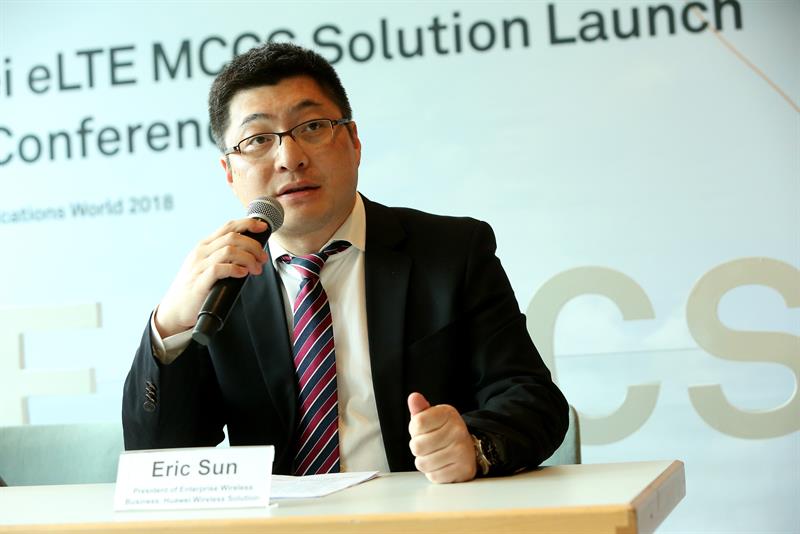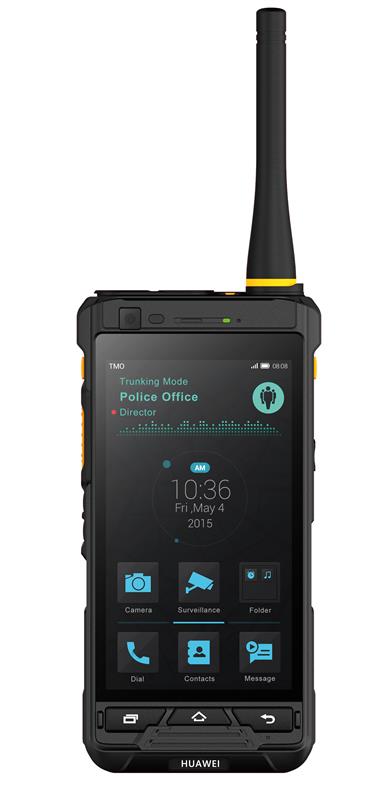Today’s public safety organisations are often frustrated by the limitations of legacy narrowband communications, with the over-dependency on voice resulting in incident commanders not getting the information they need, which in turn leads to slow decision making and inefficient procedures that can waste seconds during situations where every second counts.
While some of these issues can be addressed through the use of commercial mobile broadband networks or a separate private network for data, neither approach is ideal, given the additional costs associated with using two networks and the best-effort nature of today’s mobile networks.
Over the past few years, Huawei has become aware of these issues through working closely with its public safety customers and as a result of its in-depth research, Alex Deng, VP of Huawei Technologies says that the company came to realise that the best way to address these problems was to create a comprehensive solution that is deeply embedded into public safety user’s daily work-flows. This, the eLTE Multimedia Critical Communications System (MCCS), was recently launched at Critical Communications World. Deng explains that it “will be able to break down the barriers which create information siloes, to facilitate cross-department collaboration and create opportunities for big data mining and for better intelligence.”
Eric Sun, president of Enterprise Wireless Business at Huawei adds that “Huawei’s eLTE MCCS includes platform, network connectivity and terminals to fully integrate services for comprehensive awareness and collaboration, providing multimedia dispatching using voice, video, data and GIS.”

Eric Sun, president of Enterprise Wireless Business at Huawei
Smooth migration
The eLTE MCCS solution allows frictionless collaboration between eLTE users and those using either public networks or current narrowband trunking systems, such as TETRA, P25, and DMR). This simplifies operations and reduces the amount of time spent laboriously relaying messages. With eLTE MCCS, a one-off exchange is sufficient, simplifying workflows and processes and allowing first responders to work together in a more co-ordinated and efficient manner.
This interworking between eLTE, public broadband networks and PMR networks was successfully demonstrated in 2014, during the Asian Youth Olympic Games in Nanjing City, China. It allows public safety network operators to easily migrate over to eLTE in a gradual and phased manner, which allows them to protect any recent investments they have made, while ensuring service continuity for their end users. It also allows users to automatically fall back onto public networks should they move out of the range of their eLTE network. Furthermore, Huawei’s unlicenced spectrum solution, which was launched last year, allows users to increase the amount of bandwidth available to them for non-mission critical services in a cost-effective manner.
To ensure further resilience, eLTE terminals with external antennas have a direct mode operation (DMO) function allowing back-to-back communication in the absence of network infrastructure. eLTE also supports IOPS, which allows terminals’ services to be supported by an isolated eNodeB. Finally, the eLTE solution supports system-level geographical redundancy – should the core network fail, a backup core can take over.
The power of Huawei’s eLTE solutions to reduce response times has already been demonstrated – their deployment and use in Kenya has cut the time required to handle an incident from two hours to just 10 minutes.
The power of multimedia
eLTE MCCS enables first responders to set up a dynamic workgroup for fast response and they can see the resources around them via the GIS (geographical information system). This means that during an incident, they can easily coordinate with each other, without having to wait for a dispatcher.
The solution also allows users and dispatchers to upload and distribute videos. This is done in a very bandwidth efficient manner through the use of Evolved Multimedia Broadcast Multicast Services (eMBMS). The solution’s video streaming service has also been designed with high-speed mobility in mind. It uses automatic frequency correction (AFC) techniques in combination with LTE handover algorithms to allow streaming from vehicles to continue even when they are travelling at up to 160kph. Huawei is also conscious of the growing use of UAVs (unmanned aerial vehicles) to aid situational awareness and its eLTE chipset is available in a mini-PCIe format that allows it to be fitted to UAVs, allowing video footage from the UAV to be streamed back to the dispatcher as part of the eLTE MCCS solution. Huawei also can provide body-worn video cameras that can connect to eLTE devices via Wi-Fi, while also being eLTE-enabled in their own right, further enhancing first responders’ ability to capture and share video. eLTE MCCS seamlessly integrates with Huawei’s video cloud solution, which allows eLTE terminals to take advantage of facial recognition software, which is already in commercial use in many Chinese cities.
Huawei is also investigating the use of augmented reality by first responders to aid in the rapid identification of people of interest and to help improve officer safety. At its stand at CCW, Huawei demonstrated the use of a Google Glass style heads-up display that would allow officers to see profiles of people who are a close match to the person they’re interviewing, complete with percentage match statistics and an indication as to whether or not the match is considered dangerous, making the officer aware of any potential threat. Similarly, the increased availability of data across the eLTE MCCS platform allows big data techniques to be employed, enabling predictive policing methods, thereby allowing first responders to spend more of their time preventing crime.
On the data side, eLTE supports downlink throughput of 100 Mbit/s and uplink throughput of 50 Mbit/s, and the typical amount of data consumed by a user (using more than 30 apps) is around 100 megabytes per day (excluding video traffic).Huawei’s open and agile platform supports third party apps, giving public safety users a richer app ecosystem than would be possible in a closed single-vendor environment.

Continuous improvement
A key part of the eLTE MCCS solution, Huawei’s range of LTE broadband trunking terminals now includes the EP821 (shown right) IP68-rated rugged handportable. It is 30 per cent lighter than the EP820, Huawei’s earlier model, weighing just 347g. The EP821 runs on the Android 8.0 operating system, has a large five inch touchscreen, a hot-swappable battery and uses a 3GPP Release 13 chipset. Huawei has also launched a conventional smartphone form-factor terminal, the EP720 for use by management/non-field operators – which is just 14mm thick. Like the EP821, the IP67-rated EP720 has dedicated PTT and emergency call buttons and it has two powerful 1-watt speakers and dual microphones that use advanced noise cancelling technology to allow clear communications in noisy environments. Huawei’s terminals are designed to provide users with high reliability and to work in harsh outdoor environments – from the arctic to the burning sands of the Middle East. The terminals also use Huawei’s own chipsets and are supported by an extensive portfolio of accessories, including Bluetooth headsets. The company’s range of terminals and accessories is also available in the form factors required for in-vehicle and motorcycle use.
While much of the benefits from eLTE MCCS come from the improved situational awareness that its video and data capabilities enable, Huawei recognises that voice is the most mission-critical service and has worked hard to ensure that the latency on voice trunking group calls is less than 300 milliseconds (ms) and that for group pre-emption delays is less than 150 ms.
The company’s continuous efforts to improve the portability and convenience of its products are also clearly visible in terms of its tactical network range. Huawei has succeeded in shrinking the size of its eLTE Rapid Deployment Broadband Trunking system (which is intended for use during natural disasters and other situations where terrestrial networks may have gone down) from a relatively large grey box (launched only two years ago) to a IP67 unit that weighs just 7kg – light enough to be held in one hand. It contains an eNodeB and core network, everything needed to allow five to six nearby terminals to talk to each other and share video and data and can be set up in just five minutes
While eLTE MCCS is primarily aimed at supporting the needs of public safety users, eLTE is used in many other verticals. For example, it is being used at a Norwegian oilfield to allow the wireless transmission of production data back to the mainland over 35 kilometres away, when previously it had to be delivered via helicopter, resulting in reduced operating costs and quicker decision-making.
Why Huawei?
As the world’s largest mobile network infrastructure vendor and with a 180,000 strong workforce (45 per cent of which are engaged in R&D), Huawei can realise huge economies of scale and is driving innovation in both telecoms and public safety communications. This is supported by the company’s OpenLabs, which are based around the world and enable the company to better learn the requirements of its customers in specific markets and launch joint innovations and solutions with its local partners.
The eLTE MCCS solution is compatible with the ITU, 3GPP and MulteFire standards and supports the latest 4.5G cellular networks. Huawei plays a key role in 3GPP – out of all the participating organisations, it has submitted the greatest number of proposals. The company’s size is augmented by its collaborative approach – since it was founded in 2014, the eLTE Industry Alliance has grown rapidly and it now consists of 117 members, all of which play a role in expanding and developing the eLTE ecosystem and they can provide specific public safety applications for use on eLTE terminals.
Huawei’s expertise in public safety communications has been recognised by the industry, with the company winning the Best Integration of Future Broadband with TETRA award at the 2015 International TETRA Awards and The Future Technology Award at last year’s Critical Communications World.
Finally, as Huawei’s eLTE critical communication solution has been successfully deployed across 518 projects worldwide (of which 233 are public safety broadband networks), you can rest assured knowing that you and the first-responders you support are in safe hands.  Contact us
Contact us
If you’d like to hear more about the eLTE MCCS solution or would like to know how Huawei can assist your organisation, please contact Isaac Wang (shown right) at wangheran@huawei.com



